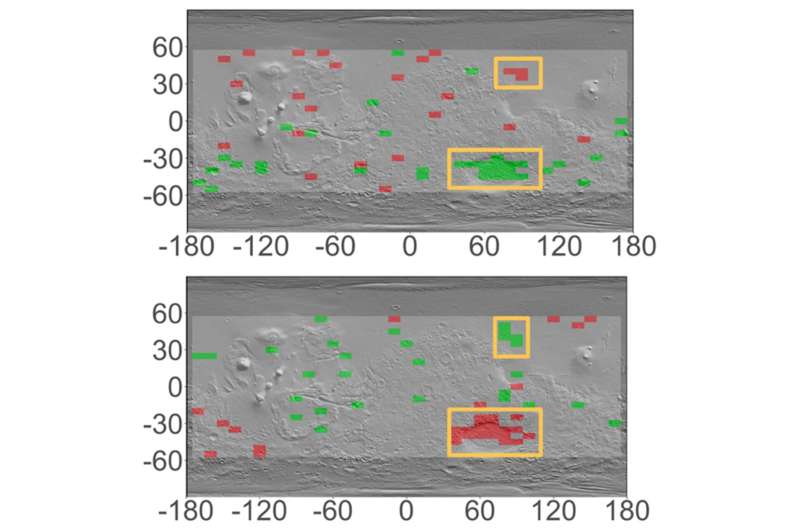An international team of researchers has used seasonal variations to identify likely sub-surface deposits of water ice in the temperate regions of Mars where it would be easiest for future human explorers to survive. The results are being presented this week by Dr. Germán Martínez at the European Planetary Science Conference (EPSC) 2021.
Using data from NASA's Mars Odyssey, which has spent almost 20 years orbiting the Red Planet, Martínez and his colleagues have identified two areas of particular interest: Hellas Planitia and Utopia Rupes, respectively in the southern and northern hemisphere. Seasonal variations in levels of hydrogen detected suggests that significant quantities water ice can be found in the meter or so below the surface in these regions.
Martínez, of the Lunar and Planetary Institute, says that "data from Mars Odyssey's Neutron Spectrometer showed signs of hydrogen beneath the surface Mars from mid to equatorial latitudes, but we still had the challenge of working out whether this is in the form of water ice, which can readily be used as a resource, or locked away in mineral salts or in soil grains and minerals. This is where the seasonal variation provides an important clue. As the coldest ground temperatures occur at the same time as the largest observed increase in hydrogen content, it suggests that water ice is forming in the shallow subsurface of these regions during the fall and winter seasons, and then sublimating into gas during the warm season of each hemisphere."
Water ice in the shallow subsurface has been found in plentiful supply at the poles. However, the frigid temperatures and the limited solar light make polar regions a hostile environment for human exploration. The areas from equatorial to mid latitudes are much more hospitable for both humans and robotic rovers, but only deeper reservoirs of water ice have been detected to date, and these are hard to reach.
To survive on Mars, astronauts would need to rely on resources already available in-situ, as sending regular supplies across the 55 million kilometers between Earth and Mars at their closest point is not an option. As liquid water is not available in the cold and arid Martian environment, ice is a vital resource. Water will not only be essential for life-support of the explorers, or the growth of plants and food, but could also be broken down into oxygen and hydrogen for use as rocket fuel.
Two other regions are rich in hydrogen: Tharsis Montes and the Medusae Fossae Formation. However, these do not display seasonal variations and appear to be the less accessible forms of water.
"Definitely, those regions too are interesting for future missions," added Martínez. "What we plan to do now for them or Hellas Planitia and Utopia Rupes, is to study their mineralogy with other instruments in the hope of spotting types of rock altered by water. Such areas would be ideal candidates for robotic missions, including sample return ones, as the ingredients for rocket fuel would be available there too."



